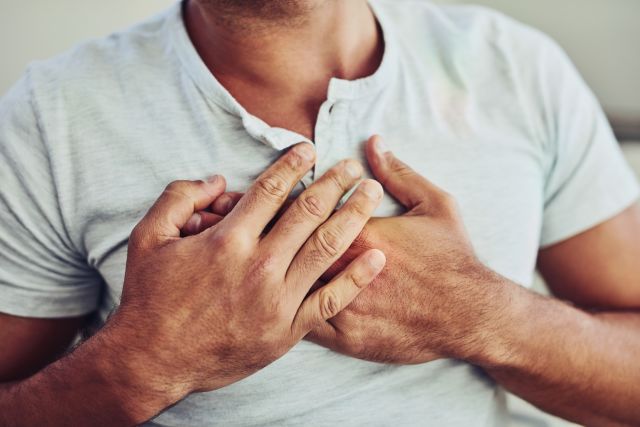Updated on March 15, 2024.
When you hear the term “sudden cardiac arrest,” you might think “heart attack.” And while the conditions are linked, sudden cardiac arrest (SCA) is a distinctly different event, with different symptoms, different treatments—and a much lower survival rate.
According to the American Heart Association, there are more than 357,000 cases of out-of-hospital cardiac arrest (OHCA) in the United States each year. Up to 90 percent of people who have OHCA die before they get to the hospital.
The good news? With prompt intervention, the outcomes for SCA can be far better.
A heart-stopping condition
“With SCA, the name gives it away—the heart suddenly and unexpectedly stops beating,” says Vinayak Manohar, MD, a cardiologist with Trinity Health Medical Group in Grand Rapids, Michigan. This abrupt loss of function is usually triggered by an electrical malfunction in the heart that causes an irregular heartbeat, called arrhythmia.
The most common arrhythmia in cardiac arrest is ventricular fibrillation (VFib). During VFib, the ventricles (the heart’s lower chambers) quiver very rapidly and erratically, preventing blood from pumping effectively. With the flow of blood disrupted, the lungs, brain, and other vital organs can’t function properly and may shut down or become damaged.
“When SCA occurs, you have precious minutes before you start suffering brain damage and, eventually, sudden cardiac death,” says Dr. Manohar.
Who’s at risk?
Sometimes, SCA occurs in active people who seem to be healthy and have no known medical conditions. But there are several known risk factors for SCA.
Chief among them is coronary artery disease (CAD, the most common type of heart disease in the U.S.) which occurs when the arteries that supply blood to the heart become hardened and narrowed. As many as 80 percent of SCA cases in adults have been attributed to CAD.
Other risk factors include:
- A previous heart attack: The majority of people who die of SCA have had a heart attack in the past, which can cause lasting damage that disrupts the heart’s electrical signals and causes irregular heartbeats.
- Family history: Heart issues among family members, including heart failure or massive heart attack—or even sudden death—may increase your chances.
- Structural damage to the heart: An enlarged heart, valve problems, and heart infections can also contribute to SCA.
- Genetic disorders: Hypertrophic cardiomyopathy, which causes the walls of the heart to thicken, is usually an inherited genetic disorder and the most common cause of sudden cardiac death among people under 30. An inherited heart rhythm disorder can also increase your risk.
- Recreational drug use or binge drinking: Recent use of cocaine, amphetamines, or marijuana—or heavy use of alcohol—can contribute to SCA, as can excessive intake of caffeine.
Certain types of physical stress can also disrupt the heart’s electrical system. These include unusually low levels of potassium or magnesium (minerals in the blood that play a role in regulating the hearbeat), severe blood loss, and severe lack of oxygen. Very intense physical activity during which the body releases the hormone adrenaline may trigger SCA in people with underlying heart issues.
In rare cases, a sudden blow to the front of the chest may also cause ventricular fibrillation (very fast, uncoordinated contraction of the lower chambers of the heart), leading to SCA. This may affect people with no preexisting heart disease, and occasionally occurs during contact sports.
Early warning signs
Despite the fact that SCA may be the first indication of a heart problem, it may not be as sudden as it’s believed to be. Research shows that symptoms frequently crop up hours, and even weeks, beforehand. One 2018 study on athletes published in Circulation found that symptoms like chest pain, shortness of breath, performance decline, palpitations (pounding or fluttering heartbeat), and fainting occurred in as many as 54 percent of cases—with about 71 percent of athletes having at least one symptom a month prior.
The warning signs aren’t just limited to athletes. A 2016 study published in Annals of Internal Medicine involving 839 middle-aged people who survived SCA found that half experienced some symptoms that indicated their heart was in danger of stopping during the month before their SCA. More than 90 percent of those who had symptoms said they returned 24 hours before their SCA.
The most common symptoms were chest pain in men and shortness of breath in women, but researchers say they can include any combination of chest pain and pressure, shortness of breath, heart palpitations, and flu-like sensations such as nausea, back pain, and/or abdominal pain.
The problem: These symptoms can be vague and often easily reasoned away. This explains why fewer than 20 percent of people in this study called for medical assistance. But for people at particular risk of SCA—because of CAD or multiple risk factors such as diabetes, high blood pressure, high cholesterol (a fat-like substance in the blood), and smoking—it’s more likely these symptoms signal a real problem that shouldn’t be ignored.
Treatment options and emergency situations
SCA can be treated and reversed, as long as emergency action is taken. Survival rates increase dramatically—doubling or tripling—if the victim receives immediate intervention. In fact, survival may be as high as 90 percent if treatment begins within a few minutes, according to a 2018 report from the American Heart Association.
If you see someone suddenly collapse or fall to the ground, are unresponsive, breathing abnormally or not at all, call 911 for help, and initiate CPR immediately.
“People usually have enough oxygen circulating in their bloodstream to buy them a good four to six minutes, providing that oxygen can be circulated through the body,” says Manohar.
CPR stands for cardiopulmonary resuscitation, and it can be a life-saving procedure. Many organizations and community centers provider CPD training course. With CPR, you alternately push on someone's chest (called chest compressions) then breathe oxygen into their mouth to keep them alive if their heart has stopped. When performing compressions, push hard and fast. Press down at least two inches on the center of the chest at a rate of 100 to 120 beats per minute—the same tempo as the Bee Gees’ song “Stayin’ Alive.” Allow the chest to come back up to its normal position after each push.
Also check if an automated external defibrillator (AED, a device that shocks the heart back into beating again) is available. If so, turn on the AED and follow the prompts and instructions to determine whether an electric shock to the heart is needed. Otherwise, continue CPR until the person starts to breathe or move, or someone with more advanced training takes over.
Once you’ve had an SCA, you’re at high risk of having it again. To prevent a second SCA, you’ll likely receive an implanted cardioverter defibrillator (ICD), a device that’s surgically placed under the skin in your chest or abdomen to monitor your heartbeat. If the ICD detects a dangerous heart rhythm, it gives an electric shock to restore the heart’s normal rhythm.
“Back in the day, we’d use medications to control arrhythmia, but we can get the same effect out of a defibrillator,” says Manohar. “It’s also much easier to control and comes with fewer side effects.” ICDs are up to 99 percent effective in stopping life-threatening arrhythmias and are the most successful therapy to treat VFib.
Simple ways to lower your risk
Following a healthy lifestyle can help reduce the likelihood of SCA, as well as the heart problems associated with it. This includes eating a healthy diet, losing weight if you’re overweight, managing stress, exercising regularly, and quitting smoking or recreational drug use and reducing alcohol intake.
Also important: “Know your personal health numbers—your cholesterol, blood pressure, and blood sugar levels—and try to keep them under control as well,” Manohar advises. Like CAD, type 2 diabetes can raise your risk of SCA two- to four-fold, according to research.
Finally, talk to your healthcare provider to gauge your risk for SCA. Being proactive now could help save your life.







